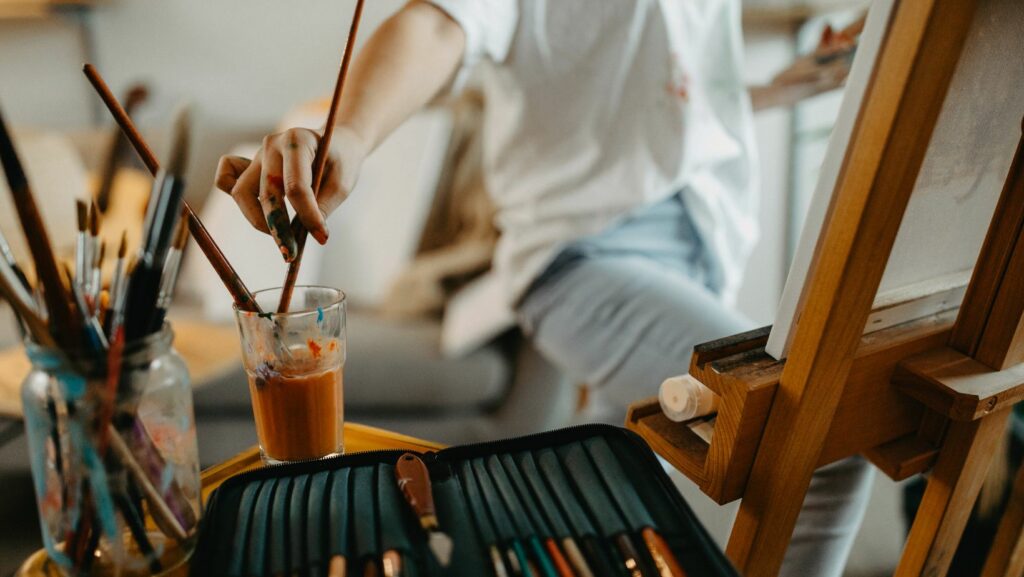Phone:
(701)814-6992
Physical address:
6296 Donnelly Plaza
Ratkeville, Bahamas.

In a world where first impressions matter, design and applied arts play a crucial role in shaping our experiences. From the sleek lines of a modern chair to the vibrant colors of a well-crafted poster, these disciplines infuse beauty and functionality into everyday life. But let’s be honest—who doesn’t appreciate a little eye candy in their surroundings?
Design isn’t just about making things pretty; it’s about problem-solving with style. Whether it’s fashion, graphic design, or interior decor, applied arts breathe life into ideas, turning the mundane into the extraordinary. So buckle up as we dive into the fascinating universe where creativity meets practicality, and discover how design and applied arts can elevate not just objects, but lives too.
Design and applied arts encompass a broad range of creative fields that emphasize functionality alongside aesthetics. Various disciplines, including fashion design, graphic design, industrial design, and interior design, reflect this core principle. Each discipline addresses specific user needs and problems while prioritizing visual appeal.
Fashion design focuses on clothing and accessory creation, integrating style with comfort and practicality. Graphic design combines text and imagery to communicate messages effectively. Industrial design enhances the usability and attractiveness of products, shaping items like furniture and electronics. Interior design transforms spaces, combining color, texture, and layout to create functional and inviting environments.
Moreover, design and applied arts often overlap, leading to innovation. For example, a graphic designer may collaborate with a product designer to create visually appealing packaging solutions. Such cooperation enriches both fields and results in enhanced user experiences.
The influence of design extends beyond mere objects. It significantly impacts everyday interactions, shaping how individuals perceive and engage with their surroundings. In addition, successful design can drive brand identity and consumer behavior, linking aesthetics with emotional connections.
Education plays a crucial role in developing talent within these fields. Many institutions offer specialized programs that combine theory and practical application, fostering creativity and problem-solving skills. Students learn to analyze user needs, understand market trends, and develop portfolios that showcase their work.
Finally, the ongoing evolution of technology continuously influences design and applied arts. Innovations in materials, techniques, and tools facilitate new creative possibilities, challenging designers to adapt and innovate. This dynamic landscape ensures that design and applied arts remain vital components of culture and society.

Design and applied arts reflect rich histories shaped by numerous movements and cultural trends. Their evolution reveals how societal changes influence creative expression.
The emergence of various design movements significantly impacted applied arts. Modernism, introduced in the late 19th century, sought functionality and simplicity, moving away from ornate styles. Bauhaus, founded in 1919, emphasized the unity of art and industry, inspiring contemporary design principles. Postmodernism arose in the late 20th century, challenging traditional ideas and celebrating eclectic styles. Each movement built upon its predecessor, creating a framework for today’s design landscape.
Cultural trends also played a pivotal role in shaping design and applied arts. The rise of minimalism reflected societal desires for simplicity and decluttering in the late 20th century. Environmental concerns led to sustainable design practices, focusing on renewable materials and ethical production. Globalization fostered cross-cultural exchanges, infusing diverse aesthetics into design. Local traditions, such as craftsmanship, maintain relevance by influencing contemporary styles, ensuring a continuous dialogue between past and present.
Design and applied arts encompass various disciplines that merge creativity with functionality. Each field addresses specific user needs and visual appeal, contributing to daily experiences.
Graphic design focuses on visual communication through typography, imagery, and layout. Designers create branded materials, advertisements, and digital content, influencing how audiences perceive information. This discipline plays a vital role in establishing brand identity and enhancing user engagement. Successful graphic design engages consumers effectively and transforms complex messages into clear visuals.
Industrial design combines aesthetics and functionality in product creation. Designers analyze user needs to develop practical and marketable solutions, often collaborating with engineers and manufacturers. This discipline addresses sustainability by integrating eco-friendly materials and processes into product design. Effective industrial design enhances the user experience and contributes to brand loyalty through innovative, well-designed products.
Fashion design revolves around clothing, accessories, and overall personal style. Designers draw inspiration from cultural movements, historical references, and contemporary trends. This discipline emphasizes individual expression while addressing seasonal collections and market demands. Successful fashion design balances creativity and practicality to meet consumer expectations while pushing boundaries in style and functionality.
Interior design focuses on enhancing interior spaces to improve aesthetic appeal and functionality. Designers consider layout, color schemes, and furniture selection to create harmonious environments. This discipline addresses both residential and commercial needs, prioritizing comfort and efficiency. Effective interior design fosters a sense of well-being and reflects the personalities of its users while optimizing space usage.
Design and applied arts play a crucial role in shaping society and driving innovation. Their impact extends beyond aesthetics, touching various aspects of everyday life.
Design influences public spaces, making them more welcoming and functional. Everyday interactions improve when thoughtful design enhances user experiences. Emotional connections often form through design, influencing purchasing decisions and brand loyalty. Enhanced communication arises from effective graphic design, allowing messages to resonate broadly. Sustainable practices in design reflect societal values, showcasing a commitment to environmental responsibility. Ultimately, design fosters cultural exchange, bridging gaps between diverse communities and promoting inclusivity.
Creative collaboration is a cornerstone of innovation in design and applied arts. Graphic designers and industrial designers often work together to create efficient product packaging. Technology integration introduces new tools that expand creative horizons. User-centered design encourages the development of solutions that cater to specific needs. Iterative processes lead to refined concepts, driving continuous improvement in products and experiences. Emerging trends nurture adaptability, ensuring that design disciplines evolve alongside societal demands.
Design and applied arts are increasingly shaped by sustainability and technological advancements, reflecting contemporary values and user needs.
Sustainability practices gain momentum in design and applied arts. Designers prioritize eco-friendly materials and processes to reduce environmental impact. For example, many fashion designers now utilize organic fabrics and recycled materials. Users show growing preference for products that adhere to sustainable principles, influencing market trends. Brands also emphasize transparency in their sourcing and production methods to build consumer trust. Implementing circular design approaches that promote reusability and recycling becomes essential in this landscape. Such efforts not only enhance brand reputation but also align with broader societal values towards sustainability.
Technological advancements continually revolutionize design and applied arts. Innovations in 3D printing allow for rapid prototyping and customization, catering to individual preferences. Designers leverage augmented reality and virtual reality to create immersive experiences, engaging users in novel ways. Additionally, smart technologies enable the integration of user feedback into product development, enhancing functionality. Data analytics play a crucial role in understanding user behavior, guiding design decisions. These advancements facilitate collaboration among designers, engineers, and marketers, fostering an environment ripe for innovation. The fusion of technology and creativity shapes the future of design, ensuring it meets evolving user demands.
Design and applied arts continue to play a pivotal role in enhancing everyday life. Their ability to blend creativity with functionality shapes not only products but also experiences. As the fields evolve with technology and sustainability in mind, they remain essential in addressing contemporary challenges.
The intersection of various disciplines fosters innovation and encourages collaboration, leading to solutions that resonate with users. By prioritizing aesthetics and practicality, design enriches cultural narratives and reflects societal values.
Looking ahead, the commitment to sustainable practices and technological advancements ensures that design and applied arts will thrive, creating a more thoughtful and connected world.